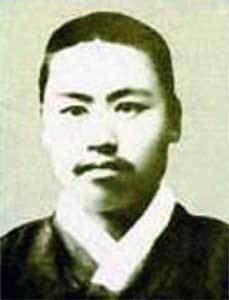Hangul 주시경 Hangul 한힌샘, 한흰메 Hanja 周時經 | Revised Romanization Ju Sigyeong Name Ju Si-gyeong McCune–Reischauer Chu Sigyong Died July 27, 1914 | |
 | ||
Revised Romanization Hanhinsaem, Hanhuinme | ||
Ju Si-gyeong (December 22, 1876 – July 27, 1914) was one of the founders of modern Korean linguistics. He was born in Bongsan County (Hangul: 봉산군鳳山郡), Hwanghae Province. He and his students helped standardize the Korean language, based spelling and grammar of the vernacular.
Contents
He studied Classical Chinese from his childhood. After studying modern linguistics in Seoul, he established the Korean Language System Society (Hangul: 조선문동식회; Hanja: 朝鮮文同式會) in 1896. He hosted several seminars in the National Language Discussion Centre of the Sangdong Youth Academy of the Korean language (Hangul: 상동청년학원국어강습소; Hanja: 尚洞青年學院國語講習所).
He proposed that the Korean parts of speech include nouns, verbs, adjectives, adverbs, unconjugated adjectives (Hangul: 관형사; Hanja: 冠形詞), auxiliaries (Hangul: 조사; Hanja: 助詞), conjunction, exclamations, and sentence-final particles (Hangul: 종지사; Hanja: 終止詞).
In his 1914 publication, Sounds of the Language, he promotes writing Hangul linearly rather than syllabically. This is one of his few proposals not to have been implemented, although there have been experiments with linear hangul, most notably in Primorsky Krai.
Publications
Miscellaneous
Ju Si-gyeong coined the name Hangul (한글) between 1910 and 1913 to identify the Korean writing system, which had existed under several other names such as onmun (vernacular script) since the 15th century.
His name is sometimes written without the disambiguity hyphen: Ju Sigyeong and Chu Sigyong. In this case, they are often mispronounced as Sig-yeong and Sig-yong respectively.
